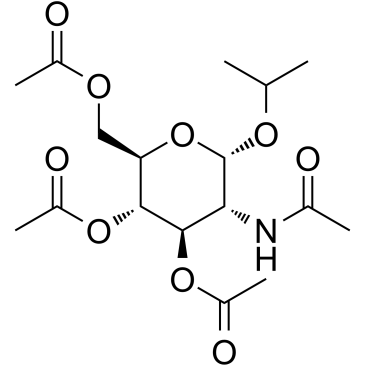| Cas No.: | 40592-88-9 |
| Synonyms: | C34,C-34,C 34;Isopropyl 2-(acetylamino)-2-deoxy á-D-glucopyranoside 3,4,6-triacetate;2-Acetamidopyranoside;Isopropyl 2-(acetylamino)-2-deoxy α-D-glucopyranoside 3,4,6-triacetate |
| SMILES: | O=C(C)N[C@H]1[C@@H](OC(C)C)O[C@H](COC(=O)C)[C@@H](OC(=O)C)[C@@H]1OC(=O)C |
| Formula: | C17H27NO9 |
| M.Wt: | 389.397 |
| Purity: | >98% |
| Sotrage: | 2 years -20°C Powder, 2 weeks 4°C in DMSO, 6 months -80°C in DMSO |
| Publication: | [1]. Neal MD, et al. Discovery and validation of a new class of small molecule Toll-like receptor 4 (TLR4) inhibitors. PLoS One. 2013 Jun 12;8(6):e65779. [2]. Wipf P, et al. Synthesis of anti-inflammatory α-and β-linked acetamidopyranosides as inhibitors of toll-like receptor 4 (TLR4). Tetrahedron Lett. 2015 Jun 3;56(23):3097-3100. |
| Description: | TLR4-IN-C34 is an orally active TLR4 inhibitor and reduces systemic inflammation in models of endotoxemia and necrotizing enterocolitis[1][2]. |
| In Vivo: | TLR4-IN-C34 (C34, 1 mg/kg, orally daily) could attenuate NEC severity and demonstrates a marked preservation of the intestinal mucosa[1]. Animal Model: Experimental NEC induced in 7-8 day old mice[1]. Dosage: 1 mg/kg. Administration: Orally every morning. Result: Attenuated intestinal inflammation. |
| References: | [1]. Neal MD, et al. Discovery and validation of a new class of small molecule Toll-like receptor 4 (TLR4) inhibitors. PLoS One. 2013 Jun 12;8(6):e65779. [2]. Wipf P, et al. Synthesis of anti-inflammatory α-and β-linked acetamidopyranosides as inhibitors of toll-like receptor 4 (TLR4). Tetrahedron Lett. 2015 Jun 3;56(23):3097-3100. |

 DC Chemicals' products qualify for U.S. tariff exemptions. We guarantee no price increases due to customs duties and maintain stable supply, continuing to deliver reliable research solutions to our American clients.
DC Chemicals' products qualify for U.S. tariff exemptions. We guarantee no price increases due to customs duties and maintain stable supply, continuing to deliver reliable research solutions to our American clients.





















